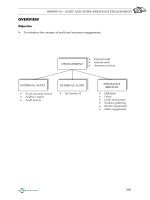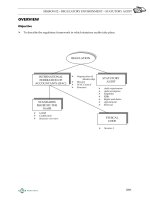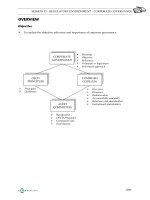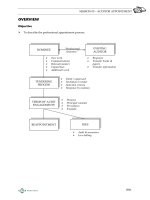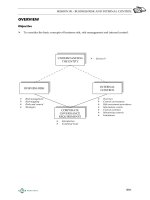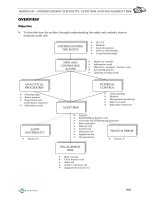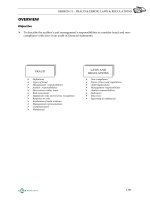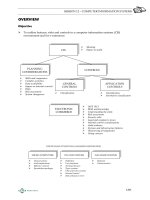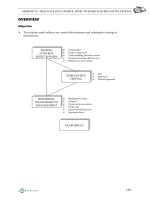ATC f8 materials FF8 AA (int)session23 j08
Bạn đang xem bản rút gọn của tài liệu. Xem và tải ngay bản đầy đủ của tài liệu tại đây (258.02 KB, 12 trang )
SESSION 23 – INVENTORY
OVERVIEW
Objective
To identify and explain areas of risk.
To apply procedures to obtain appropriate audit evidence.
INVENTORY
SYSTEM
SOURCES OF
EVIDENCE
IMPORTANCE
Types of inventory
Materiality
Control objectives
Internal control
examples
“Ideas list”
RISKS
C
“CUTOFF”
Importance
Audit procedures
A
P
E
IAS 2
PHYSICAL
INVENTORY
COUNTING
Measurement
Cost formulas
NRV
Provisions
Purpose
Types of stocktaking
Perpetual inventory
Physical counting
R
THIRD PARTY
INVENTORY
Inventory held by other
parties
Third party inventory
Reservation of title
A comprehensive audit program for inventory is set out in Appendix 3 and must be studied.
2301
SESSION 23 – INVENTORY
1
IMPORTANCE
1.1
Types of inventory
Raw materials and consumables
Work in progress
Finished goods and goods for resale
Long-term contracts.
1.2
Materiality
Balance sheet
Current assets
Inventory
Income statement
Revenue
Cost of sales *
x
Gross profit
x
(x)
___
x
___
* = Opening inventory
+ Purchases (+ conversion costs)
– Closing inventory
Inventory is frequently material
to both BS & IS
2
SOURCES OF EVIDENCE
Example 1
Complete the following ideas list.
2.1
“Ideas list”
Accounting systems
⇒
Documentation
⇒
Tangible assets
⇒
Management and employees
⇒
Customers and suppliers
⇒
Other third parties (e.g. banks,
solicitors)
⇒
Analytical procedures
⇒
2302
SESSION 23 – INVENTORY
3
INVENTORY SYSTEM
3.1
Control objectives
To ensure that …
Stage 1
Goods received
Goods despatched
… damaged goods are not accepted.
… goods cannot be misappropriated.
Stage 2
Receipt recorded
Despatch recorded
Movement posted to
general ledger and
inventory records
Stage 3
3.2
Internal control examples
3.2.1
Goods received
… all movements are accurately
recorded.
… management has accurate/timely
info concerning inventory levels.
Physical inspection
Securely stored
3.2.2
Goods dispatched
Two warehouse employees involved
Maintain “open orders” file
Notification of “stock-outs”
3.2.3
Receipt recorded
Serially numbered goods received notes (GRNs) sequentially controlled
Matched to purchase order
3.2.4
Dispatch recorded
Serially numbered dispatch notes (DNs) sequentially controlled
Customer signature (proof of delivery)
Matched with customer order
Serially numbered goods returned notes
3.2.5
Postings
GRNs and DNs used to update inventory records
GRNs and DNs evidenced as processed (e.g. stamped) and filed numerically
Regular physical inventory counting, comparison book v actual and
variances investigated.
2303
SESSION 23 – INVENTORY
4
RISKS
Not all quantities of materials, goods etc may be recorded on stocksheets.
Inventory may not be adequately safeguarded.
Inventory may not be valued consistently and in accordance with IAS 2 Inventories.
“Cutoff” for inventory movements may be inaccurate.
Inventory belonging to third parties may not be excluded from physical count.
Inventory with third parties belonging to the client may be omitted from count.
5
“CUTOFF”
A procedure for isolating the flow of inventory, cash and related documentation to ensure
that all aspects of a transaction are dealt with in the same accounting period.
5.1
Importance
Accurate “cutoff” may be crucial to inventory, purchases and sales. Cutoff determines
where one accounting period ends and another one commences.
PURCHASES
receive inventory
receive inventory
YEAR END
despatch inventory
despatch inventory
INVENTORY
Errors or inconsistencies in cutoff can create misleading measurements of profit.
Illustration 1
A purchase invoice for 5,000 tons of metal worth $1m was received on 5 April
for goods received on 31 March, and the business has a yearly reporting period
ending 31 March. The metal must be included in the figure for trade payables.
If, due to an error, the invoice was not entered in the records until the new
period had commenced, then profits in the preceding period would be
overstated by $1m.
2304
SESSION 23 – INVENTORY
Illustration 2
If goods invoiced to a customer (worth $10,000 at cost) were erroneously
included in the closing inventory, there would be an element of double
counting and profits would be overstated by $10,000.
5.2
Audit procedures
To avoid double counting it is essential that purchase and sales invoices are checked
against inventory records to ensure that:
all goods received into inventory by the end of the reporting period and included in
the statement of financial position have the corresponding invoice entered in the
purchase day book and included in trade payables
all goods despatched at the end of the reporting period and excluded from the
statement of financial position have a corresponding sales invoice raised, entered in
the sales day book and included in trade receivables.
To avoid omissions, all purchase or sales invoices entered in the books before the end of
the reporting period must have the corresponding inventory movement reflected in the
statement of financial position inventory.
6
VALUATION AND IAS 2
Lower of cost and net realisable value for separate items of inventory.
6.1
Measurement methods
6.1.1
Standard cost
It must approximate to actual. Price variance accounts will highlight obvious
differences between standard and actual price.
6.1.2
Retail method
Selling price less standard gross profit %.
% may be average for each “department”.
Suited to large numbers of rapidly changing items having similar margins.
2305
SESSION 23 – INVENTORY
6.2
Cost formulas
Specific identification of individual costs. Need to confirm:
material costs to suppliers’ invoices
labour to payroll and time summaries
the basis of unit cost calculations for allocating overheads.
Otherwise (for interchangeable items):
First-in, first-out (FIFO)
Weighted average
6.3
Net realisable value
NRV is affected by
obsolescence
condition/damage etc
market price fluctuations.
In computerised inventory systems, an exception report may identify items which have
not moved in a specified period.
A review of selling prices after the end of the reporting period may confirm
NRV.
6.4
“Allowances”
An example of an “accounting estimate” which is an allowance
Determination may be
simple (e.g. a % of inventory value); or
complex (e.g. by analysing current data and sales forecasts to estimate slow-moving
or surplus inventory).
Any formulae used (e.g. different %s applied to inventory ageing) need to be reviewed
regularly by management to assess their appropriateness.
Audit approaches
Review and test management’s process used to develop the estimate
Use an independent estimate for comparison with management’s
Review after-date sales to confirm the estimate made.
2306
SESSION 23 – INVENTORY
7
ATTENDANCE AT PHYSICAL INVENTORY COUNTING [ISA 501]
When inventory is material … the auditor should obtain sufficient appropriate audit
evidence regarding its existence and condition (⇒ valuation) by attendance at physical
inventory counting unless impracticable.
7.1
Purpose
To inspect inventory.
To observe compliance with the operation of management’s procedures for recording
and controlling the results of the count.
To provide evidence as to the reliability of management’s procedures.
7.2
Types of stocktaking
Full physical
count
Before/after
y/e
Perpetual
system
At y/e
Example 2
Suggest advantages and disadvantages of a full physical count at the end of the
reporting period.
Solution
Advantages
Disadvantages
2307
SESSION 23 – INVENTORY
Example 3
Suggest advantages and disadvantages of a full physical count shortly before
the end of the reporting period.
Solution
Advantages
7.3
Disadvantages
Perpetual inventory system
Inventory is counted on a regular basis and just not once (at the end of the reporting
period). Acts as a check on the accuracy of the book records (usually computerised
incorporating purchases and movements between raw materials, work-in-progress and
finished goods).
Counts should be programmed so all inventory (eg each product line) counted at least
ONCE a year (i.e “continuous stocktaking”). High value items/product lines are
usually counted more often, eg every month or in some cases (eg high value jewellery)
every day.
All material differences between book inventory and physical counts must be
investigated and corrected at the time of each count.
Auditors should attend at least one of the physical counts (preferably more than one if
inventory is homogeneous and each product line is counted only once).
Movements throughout the year into book records (eg from goods received records)
and out (eg transfers to next production stage/goods out as sales) must be audited to
establish occurrence and measurement assertions.
This is necessary to support the assertion that quantity records are reliable (existence
and completeness) as a basis for the determination of the year-end valuation.
Example 4
Suggest advantages and disadvantages of a perpetual inventory system.
2308
SESSION 23 – INVENTORY
Solution
Advantages
7.4
Disadvantages
Attendance at physical inventory counting
Applies equally to end of the reporting period counts and perpetual inventory counts.
Before =
Planning
During =
Attendance
review prior year
working papers
observe compliance
with instructions
discuss instructions
with management
perform test counts
(from physical to
recorded and vice
versa)
familiarisation; nature,
value, location(s) etc
arrange third party
certificates
consider need for
expert(s)
assess accounting and
internal control
system
take copies of
stocksheets
obtain more details of
damaged inventory
note cutoff details.
After =
Follow-up
follow up cut-off tests
check “in bulk” copies
of stocksheets and
check sequence
ensure perpetual
inventory records
adjusted
follow up third party
certificates
conclude on reliability
of quantities used as a
basis for computing
inventory.
consider role of
internal audit
extract representative
sample.
An audit program for attendance is set out in Appendix 3 and must be studied.
2309
SESSION 23 – INVENTORY
8
THIRD PARTY INVENTORY
8.1
Inventory held by other parties
Client’s inventory may be held by third parties when
third party warehousing/storage is being used
goods are on consignment
goods are in transit.
If the inventory held by third parties is material, it must be inspected by the auditor or
alternative evidence sought for goods that cannot be inspected (eg in transit on board a
boat – inspect shipping documentation, insurance arrangements, subsequent arrival
and offloading, confirmation letter from agents, management representations).
If the inventory is not material, a confirmation letter should be obtained from the third
party.
8.2
Third party inventory held by client
Where inventory is received from a third party, eg for processing ( electroplating) or
repair (under warranty) the auditor must consider the controls in place to ensure such
inventory is not included within the inventory of the entity (eg identified and
segregated at the time of a physical inventory count).
8.3
Reservation of title
Suppliers may include a “reservation of title” clause in their contracts of sale (usually
on the purchase invoice). This states that title (i.e. ownership) of the goods does not
pass to the customer until paid for, even if the goods are used within the
manufacturing process before payment.
Considering substance over form:
Legal form – goods belong to supplier until fully paid for. No liability or asset is
recognised.
Commercial substance – goods are treated as property of purchaser, who
recognises the liability and includes such goods held at the end of the reporting
period on their statement of financial position.
Commercial substance takes precedence unless there are significant going concern
doubts – in which case strict legal form should be recognised.
2310
SESSION 23 – INVENTORY
FOCUS
You should now be able to:
explain the importance of inventory;
describe physical inventory counting procedures;
explain “cutoff”;
value inventory;
select appropriate audit procedures for inclusion in a work program (see also Appendix
3) relating to financial statement assertions concerning inventory.
EXAMPLE SOLUTION
Solution 1 — Sources “Ideas list”
Accounting systems
⇒
Perpetual inventory records
Documentation
⇒
Inventory cards, purchase invoices (cost)
(also payroll for manufactured products),
sales invoices (NRV)
Tangible assets
⇒
Raw materials, WIP, finished goods
Management and employees
⇒
Buyer, storekeeper
Customers and suppliers
⇒
Major (raw material) suppliers, customer
complaints (NRV < cost?)
Other third parties (e.g. banks,
solicitors)
⇒
Bank (floating charge?), warehousing agents
Analytical procedures
⇒
Inventory turnover by product category, GP
margin review
2311
SESSION 23 – INVENTORY
Solution 2 — Full count
Advantages
Disadvantages
Evidence most
effective/inventory physically in
BS
Potential disruption and cost of full count
(e.g. if production halted or outlets closed)
“Cutoff” ascertained at just one
(end of the reporting period)
date. Movements to be
confirmed are minimised
Number of locations to be attended at one
time (by client and audit staff)
Inventory records are not
required.
Heavy demand on audit staff at popular
end of reporting periods (e.g. 31
December).
Solution 3 — Before end of the reporting period
Advantages
Disadvantages
Time can be made more
convenient (e.g. holiday closure)
Movements to be substantiated therefore
need records and ICs (to confirm “roll
forward”)
Still time to do full count at the
end of the reporting period if
significant problems found
“Cutoff” needs to be examined at count
date and the end of the reporting period
also
Facilitates a tighter audit
reporting deadline
Reliable inventory records required
Solution 4 — Continuous stock-checking
Advantages
Disadvantages
A method of internal control –
operates throughout year
Requires adequate inventory records be
kept up-to-date (⇒ clerical cost)
Material and risk prone items can
be confirmed at any time
No full counts
The end of the reporting period
count of certain (e.g. high value)
items is not precluded
The end of the reporting period “cut-off”
tested separately
2312
